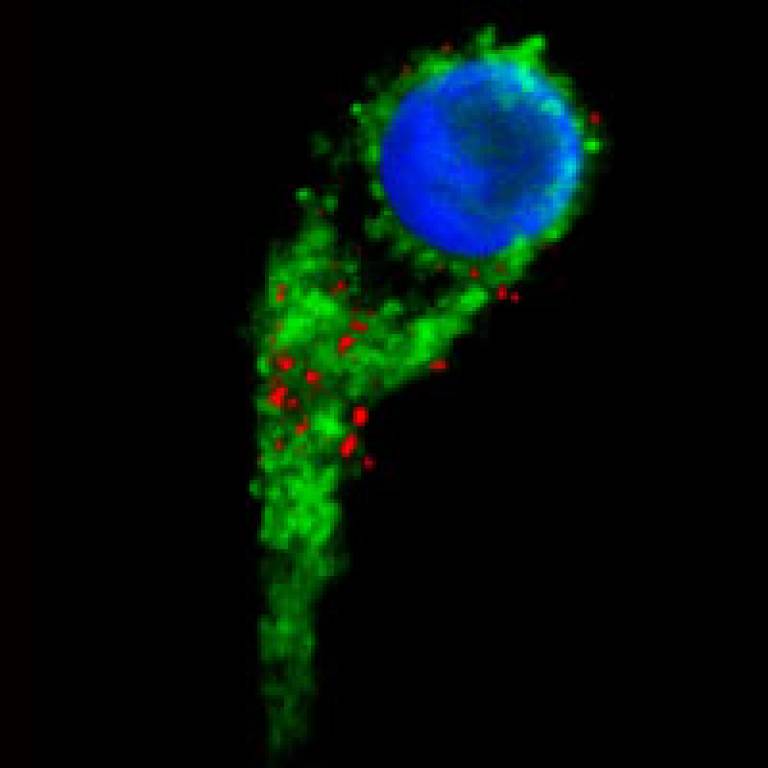Nano-magnets guide stem cells to damaged tissue
17 August 2009
Press release Links:
 ucl.ac.uk/cabi/" target="_self">UCL Centre for Advanced Biomedical Imaging
ucl.ac.uk/cabi/" target="_self">UCL Centre for Advanced Biomedical Imaging
Microscopic magnetic particles have been used to bring stem cells to sites of cardiovascular injury in a new method designed to increase the capacity of cells to repair damaged tissue, UCL scientists announced today.
The cross disciplinary research, published in The Journal of the American College of Cardiology: Cardiovascular Interventions, demonstrates a technique where endothelial progenitor cells - a type of stem cell shown to be important in vascular healing processes - have been magnetically tagged with a tiny iron-containing clinical agent, then successfully targeted to a site of arterial injury using a magnet positioned outside the body.
Following magnetic targeting, there was a five-fold increase in cell localisation at a site of vascular injury in rats. The team also demonstrated a six-fold increase in cell capture in an in-vitro flow system (where microscopic particles are suspended in a stream of fluid and examined to see how they behave).
Video: Human cells labelled with nano-magnets are attracted by an external magnet. In this video, the microscope is focused on the edge of a drop of cell-containing culture medium. When a magnet is placed near one side of the drop, the cells rapidly move toward it.
Although magnetic fields have been used to guide cellular therapies, this is the first time cells have been targeted using a method directly applicable to clinical practice. The technique uses an FDA (US Food and Drug Administration) approved agent that is already used to monitor cells in humans using MRI (magnetic resonance imaging).
Dr Mark Lythgoe, UCL Centre for Advanced Biomedical Imaging, the senior author of the study, said: "Because the material we used in this method is already FDA approved we could see this technology being applied in human clinical trials within three to five years.
"It's feasible that heart attacks and other vascular injuries could eventually be treated using regular injections of magnetised stem cells. The technology could be adapted to localise cells in other organs and provide a useful tool for the systemic injection of all manner of cell therapies. And it's not just limited to cells - by focusing tagged antibodies or viruses using this method, cancerous tumours could be much more specifically targeted."
Panagiotis Kyrtatos, also from the UCL Centre for Advanced Biomedical Imaging and lead researcher of the study, added: "This research tackles one of the most critical challenges in the biomedical sciences today: ensuring the effective delivery and retention of cellular therapies to specific targets within the body.
"Cell therapies could greatly benefit from nano-magnetic techniques which concentrate cells where they are needed most. The nano-magnets not only assist with the targeting, but with the aid of MRI also allow us to observe how the cells behave once they're injected."
John Martin, Professor of Cardiovascular Medicine at UCL, is another of the paper's co-authors. He commented: "UCL is already leading clinical trials in stem cells in repairing the damaged heart. This paper describes how a second generation of improved cells might be targeted to damaged areas. Research such as this directly informs the future design of clinical trials. It is a great reminder that clinical research must be informed by basic research and that results from scientific laboratories can be highly relevant to clinical medicine, and to patients."
Professor Quentin Pankhurst, London Centre for Nanotechnology and Director of the Royal Institution Davy-Faraday Research Laboratory, added: "Magnetic particles have been used as MRI contrast agents for more than a decade, and are both safe and convenient for use in the body. Using them as tags on cells and using external magnets to capture them in the bloodstream is, however, an entirely new prospect which may open the door to many new possibilities for targeted cell and drug delivery."
This work was supported by public and charitable funding from the UCL Institute of Child Health (Child Health Research Appeal Trust), British Heart Foundation (BHF), the Alexander S. Onassis Public Benefit Foundation and the Biotechnology and Biological Sciences Research Council (BBSRC).
Image: Microscopic image of a human cell (green cytoplasm, blue nucleus) loaded with mini-magnets (red)
Media contact: Ruth Howells
UCL context
The Centre for Advanced Biomedical Imaging is a new multidisciplinary research centre for experimental imaging. The centre is built around a number of groups at UCL and brings together in vivo imaging technologies across UCL with specific applications in the biomedical sciences.
Related stories:
Nanoscale research uses spin to revolutionise how computers work
UCL offers cutting-edge MSc in Nanotechnology and Regenerative Medicine
 Close
Close

